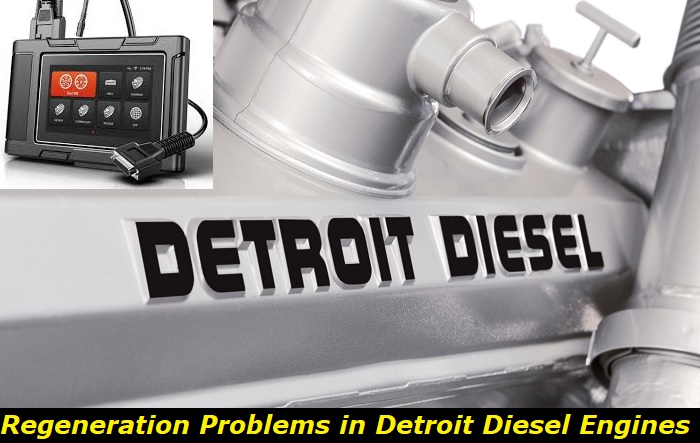Detroit Diesel Regeneration Problems: Understanding and Fixing
The Diesel Particulate Filter (DPF) is a critical device in modern vehicles, particularly those with diesel engines. Its primary function is to capture and contain particulate matter (PM) emissions, effectively preventing them from being released into the environment. The DPF's efficiency is noteworthy, eliminating upwards of 90% of particulate matter, aligning with stringent emission standards in both Europe and North America for all diesel engine vehicles.

This device operates by employing a series of mechanisms, including inertial deposition, flow-line interception, and diffusion deposition. These processes work in tandem to trap, collect, and subsequently eliminate particulate matter from the system through a method known as thermal regeneration. The DPF stands out for its proficiency in controlling and reducing PM emissions, contributing significantly to cleaner air.
The advanced DPF goes beyond just capturing solid diesel particulates like elemental carbon or soot; it also addresses:
- The reduction of black smoke emissions.
- The control of non-solid fractions, such as sulfate particulates and other oxidation catalysts.
To effectively target non-solid particulates, which are particularly prevalent with low sulfur fuels, the DPF incorporates additional components. The filter operates at sufficiently high temperatures, ensuring all particulates are consistently oxidized using exhaust gases. This oxidation process can be enhanced with catalysts, which help lower the temperature required for soot oxidation.
Speaking of soot, the DPF can accumulate substantial amounts of this solid carbon matter in a relatively short timeframe. The exact quantity depends on the vehicle's usage, but it can range from several liters to kilograms in a single day. This rapid accumulation is due to the low density of diesel particulate matter, typically below 0.1g/cm^3. While the DPF plays a crucial role in capturing soot, it does have its limitations. The filter’s capacity is not extensive, and depending on the vehicle’s activity, it might only last a few hours to a few days before requiring intervention.
Fortunately, the DPF is equipped with a particulate removal mechanism known as DPF regeneration. This process is essentially a self-cleaning function, allowing the filter to continuously clear itself of solid particulate matter, maintaining its efficacy and purpose.
DPF regeneration is categorized into two main types:
- Passive Regeneration: This occurs naturally as the vehicle is in motion, particularly at higher speeds on highways, which leads to an increase in exhaust temperature and triggers the regeneration process.
- Active Regeneration: This is necessary when the vehicle is not reaching the high exhaust temperatures typically seen on highways. Active regeneration kicks in when soot levels reach around 45%, prompting the vehicle to inject fuel to increase exhaust temperatures and initiate the regeneration process. Additionally, there is a "Parked regeneration" option, where the driver can manually activate the regeneration process when the vehicle is stationary.
This article serves as a comprehensive guide on Diesel Particulate Filters, outlining their purpose, function, and the critical role they play in reducing air pollution from diesel vehicles.
Regeneration Problems
Regeneration issues are a prevalent concern with Diesel Particulate Filters (DPF), predominantly manifesting as either an incomplete or entirely failed regeneration process. Occasionally, attempts to manually initiate regeneration may prove futile. A multitude of factors can lead to these regeneration complications, often culminating in filter blockages or, in extreme cases, filter melting due to excessive soot accumulation.
One primary reason for regeneration failure is inadequate vehicle speed, preventing the initiation of continuous regeneration. Similarly, too short of a journey can result in an incomplete active regeneration cycle, even after being manually triggered. The vehicle's dashboard indicators and instrument cluster play a crucial role in alerting the driver to potential regeneration issues and associated problems.
In addition to vehicle speed and journey length, other potential catalysts for regeneration failure include:
- Utilizing the Incorrect Oil: The type of engine oil used significantly impacts the volume of ash and other emissions produced, influencing the DPF's ability to regenerate.
- Faulty Multifunctional Temperature Sensors: The exhaust system houses various sensors to monitor temperatures at each stage of the after-treatment and filtration process. These sensors are vital in managing the regeneration process; if they malfunction, the entire process could be jeopardized.
- Inadequate Soot Levels: Some engines require a specific soot percentage to activate regeneration. Failing to reach this threshold means any regeneration attempt is doomed to fail. Furthermore, an excessive accumulation of soot and ash can obstruct the system, preventing the filter from reaching the necessary temperature to initiate regeneration.
- Issues with the EGR System: A clogged Exhaust Gas Recirculation (EGR) system can lead to air and fuel inlet issues, resulting in incomplete combustion and, subsequently, an overwhelmed exhaust system and DPF. The increased soot load makes regeneration exceedingly difficult, if not impossible.
- Insufficient Fuel: Regeneration requires additional fuel to raise exhaust temperatures. If the tank's fuel level falls below 25%, there may not be enough fuel to facilitate this process, resulting in an incomplete or failed regeneration.
- Blocked Diesel Oxidation Catalyst (DOC): The DOC is a vital component in the after-treatment system, containing a metal catalyst that oxidizes various exhaust particles. A blockage here can restrict exhaust flow, hampering the regeneration process.
- Air Conditioning Usage: Utilizing the air conditioning can cool the engine to a level where it cannot generate the necessary temperatures for regeneration, necessitating that it be turned off during the process.
- Turbocharger Malfunctions: A faulty turbocharger can introduce cooling oil into the DPF system, leading to failure. Additionally, if the turbocharger is not providing adequate air to the combustion chamber, the necessary heat for regeneration may not be achieved.
- Active Engine Fault Codes: The Engine Control Module (ECM) may display fault codes that prevent DPF regeneration. Resolving the original fault code is a prerequisite for running the de-rate code and initiating regeneration.
- High Vehicle Mileage: Vehicles with extensive odometer readings are more prone to DPF regeneration failures.
Addressing these issues promptly is crucial to maintaining the DPF's functionality and ensuring the longevity of the vehicle's exhaust system. Regular maintenance and adherence to manufacturer guidelines can mitigate the risk of regeneration problems, ensuring the DPF performs optimally.
Symptoms of Regeneration Failure
Regeneration issues in a Diesel Particulate Filter (DPF) often manifest through a series of warning signals on a vehicle's dashboard. In modern cars, you can expect the DPF light and the Engine Management Light (EML) to illuminate, alongside various error codes, signaling potential problems with the DPF regeneration process. Following these warnings, more noticeable symptoms might occur, including:
- Loss of engine power
- Difficulty starting the engine
- Reduced fuel efficiency
- Unpleasant odors or visible exhaust emissions
- Decreased throttle response
While these symptoms might not definitively indicate a DPF failure, they serve as vital clues prompting the driver to verify whether the DPF is regenerating correctly.
Effects of Regeneration Failure: Failed regeneration attempts can lead to serious issues. Extra fuel intended for burning soot within the DPF can end up in the sump, diluting the engine oil. This not only compromises the oil's quality, leading to elevated oil levels, but also poses a severe risk of engine damage.
Under normal circumstances, when the DPF light activates, driving at speeds above 65 km/hr for a minimum of 10 minutes should facilitate complete regeneration. Ignoring this, or if regeneration fails, a secondary warning light will appear once soot accumulation reaches 75%. At this point, forced regeneration becomes necessary, typically requiring professional assistance.
Should soot levels escalate to 85% without intervention, replacing the DPF might be the only solution, as burning off the soot becomes increasingly impractical.
Addressing DPF Issues
To maintain your DPF and address potential issues:
- Drive at highway speeds: Maintain speeds above 65 km/hr for approximately 25 minutes, ensuring engine revs are around 2500 rpm. This practice aids passive DPF regeneration.
- Avoid city driving when the DPF light is on: Urban driving conditions can lead to soot accumulation. Engage in occasional high-speed drives with brisk accelerations to increase exhaust temperatures and burn off soot.
- Respond to DPF warnings: When the DPF warning light activates, increase engine rpm for an extended period until the light deactivates, signaling successful soot combustion.
- Use diagnostic tools: Employ a diagnostic tool with a DPF regeneration function to initiate forced regeneration when necessary, which should take about 45 minutes.
- Opt for quality fuel: High-quality fuels, inclusive of additives, aid in burning harmful particles in the engine exhaust.
- Be strategic about driving routes: When the DPF light illuminates or you're nearing the soot limit, opt for open highways to facilitate regeneration, avoiding city streets.
While DPF systems are generally reliable and efficient, they are not immune to failure or potential negative impacts on the engine and driving experience. Adhering to the manufacturer's maintenance requirements is crucial to ensure optimal DPF performance.

Add comment